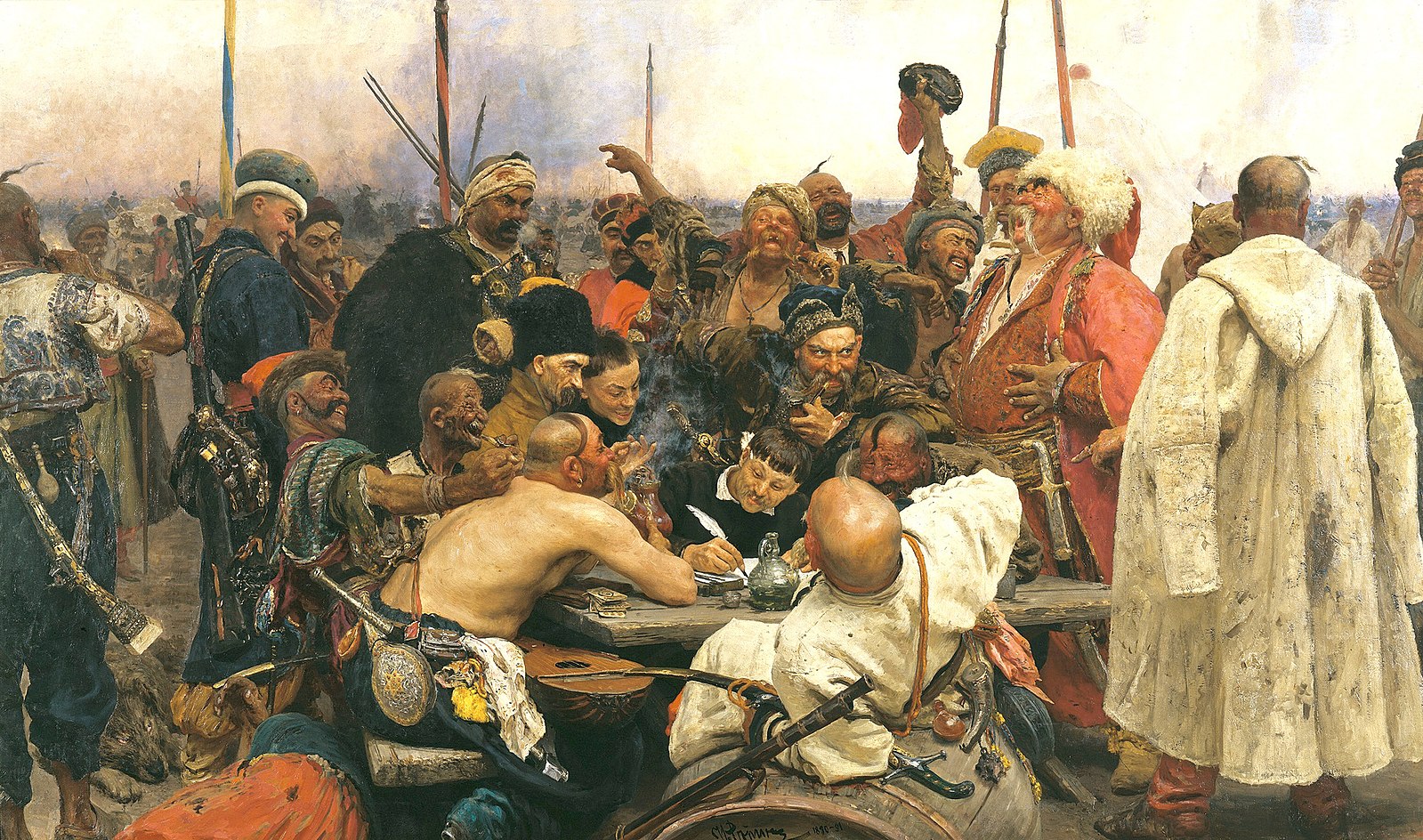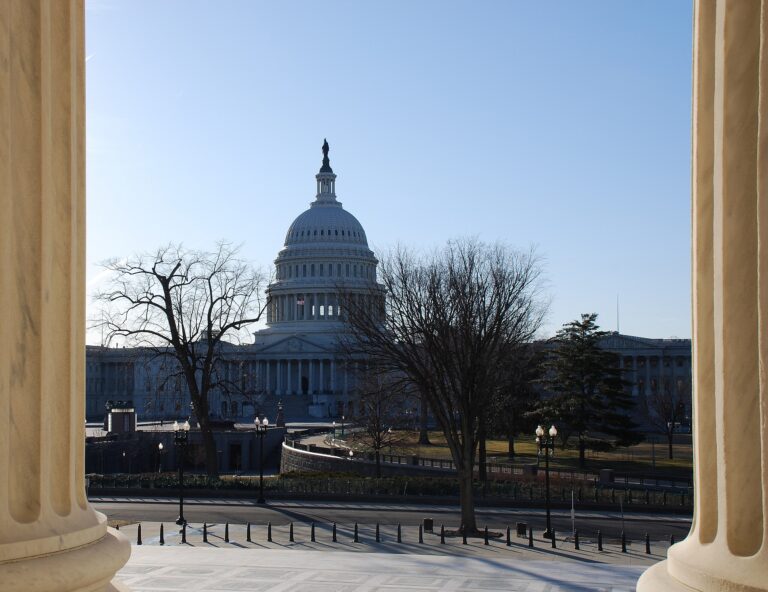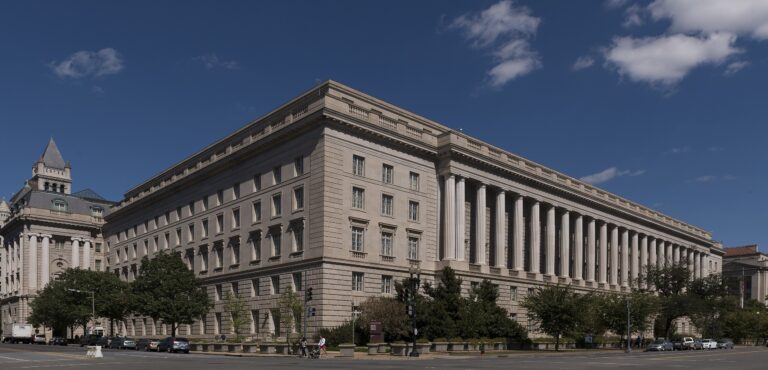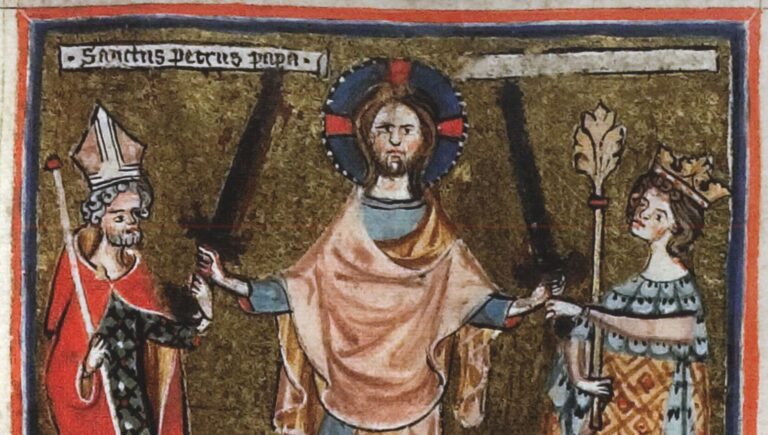
Religious Belief as an Existential Threat:
How Russia Victimizes Religious Minorities in Russia and in the Occupied Territories of Ukraine
Dr. Kyriaki Topidi
“Reply of the Zaporozhian Cossacks” by Ilya Repin (CC0)
This article is part of our series on Transnational Christian Nationalism, and its impact on politics, the rule of law, and religious freedom. If you’d like to explore other articles in this series, click here.
Russia counts more than 200 ethnic groups among its more than 140 million population. According to a 2024 Public Opinion Foundation (FOM) census, 62 per cent of Russians identify as Orthodox Christians, 3 per cent as other Christians, 9 per cent as Muslims, 21 per cent as nonreligious and 4 per cent as unsure of their beliefs. Other religious minority groups present in the country include Baha’is, Falun Gong practitioners, Scientologists, members of The Church of Jesus Christ of Latter-day Saints, Tengrists, followers of indigenous religious, and believers of the International Society for Krishna Consciousness. Among religious minority groups, Muslims are the largest religious minority with an estimated 25 million adherents, followed by 1 million Buddhists, 2 million Protestants, 600,000 Catholics and a Jewish population ranging between 250,000 and 1 million adherents. Despite this ethno-cultural diversity, the country’s record of protection of religious freedoms is alarming. The U.S. State Department has designated Russia a country of particular concern in relation to religious freedom. This designation suggests a problematic record in terms of the degree of protection of religious freedoms. This record is the result of a regressive legislative record on religious freedoms but also of the active promotion of its more recent mono-religious national narrative.
A regressive record of lawmaking towards religious minorities
The Russian Christian Orthodox identity has enjoyed a “ruling and predominant status” since at least the 1832 Fundamental Laws of the Russian Empire. At the time, conversion to a “foreign faith” was a criminal offence, conflating Russianness with the Orthodox religion. While some degree of religious toleration emerged from the middle of the eighteenth century, the regime was characterized at the time by the selective recognition of minority confessions. Any state recognition was conferred under conditions of strict state scrutiny and control. Within this system labelled as “custodial toleration,” religious minorities were able to self-govern although only to limited extents. Depending on the status of the religious minority group, including through their positioning within a hierarchical structure, religious minorities deployed a variety of strategies towards survival that ranged from close cooperation with the Empire to outward resistance.
Religious minority identity throughout Russia’s recent history, has been used, however, as a source of resistance to imperial control. Processes of assimilation and conversion of members of such groups remain historically ambiguous (see for example the case of the Jewish minority in the early twentieth century). During the Stalinist regime, when religious minority groups and believers were pushed to the margins, some religious minorities, such as the Jehovah’s Witnesses and the Evangelical Baptists, stood out as victims of particularly severe repression. From 1928 to the Second World War, the Communist Party closed churches, synagogues, and mosques and ordered the murder and imprisonment of thousands of religious leaders deemed “anti-revolutionary.” Of particular relevance to understanding the current situation of religious minorities in Russia is the fact that criminal prosecution in the Soviet Union happened on the basis of anti-Soviet or antisocial activities rather than beliefs and practices. This strategy placed the right to religious freedom outside the legal frame of prosecutions. Alongside this approach, the Soviet Union emphasized its diversity through the creation and promotion of the narrative of “Soviet nationalities” that ultimately became the main conceptual umbrella replacing religious diversity.
With the collapse of the Union came a brief period of religious freedoms, which were recognized within the 1990 Law on the Freedom of Religions, which established the separation of church and state. It also created the conditions for religious minorities to flourish, including through the emergence of new religious groups, such as the Latter-day Saints and the New Generation Church, as well as movements around the Tablighi Jamaat, Hizb ut-Tahrir or the Gülen movement. These groups have been firmly opposed by the Russian Orthodox Church under the Moscow Patriarchate. The 1997 Law on Freedom of Conscience and Religious Associations gradually introduced a string of restrictive legislative enactments that laid the foundations for a hierarchy of religious groups within Russia. The law proclaimed that the Russian Orthodox Church had a “special role in the development of Russia, in the formation and development of its spirituality and culture.” Religious communities were categorized by the law in three groups: the first, labelled “traditional religious groups,” includes Orthodox Christianity, Judaism, Islam, and Buddhism. These faith groups are placed in the same group because they are considered historically rooted in Russia. The second group covers “non-traditional religious groups,” that mostly include Protestant groups. The third and last category of groups covers a wide spectrum of religious and belief groups that are banned in the country, such as Jehovah’s Witnesses. Subsequent legislative acts, such as the 2006 Law on Public Associations, increased further the vulnerability of religious minority groups. Once more, the trajectory for victimizing religious minority groups was to treat them as dangers to society and the state (see, for example, the Extremism Laws of the early 2000s).
More recently, the Yarovaya-Ozerov Law of 2016 has punished “illegal missionary activities” to be understood as any religious activities not licensed or sanctioned by the State. The 2016 Law is indicative of the intention of the State to use the legal framework at its disposal repressively while extending its options to control and regulate religious activities within minority faith communities. It also echoes the historic discrimination and stigmatization of religious minorities, as reflected also in the categorization of religious minority groups. In 2020, several amendments to the Russian religious law have further restricted religious freedom of religion or belief. The new requirements of law stipulate that employees or priests of religious organizations receiving spiritual education outside Russia are required to undergo reeducation and recertification in Russia. In addition, the persons included in the List of Terrorists and Extremists of the Russian Federal Financing Monitoring Service cannot be leaders or participants of religious groups. The use of religious buildings by religious minorities has become equally problematic. Authorities have required the demolition of buildings in use by minority religious organizations, very characteristically affecting Evangelical Christians.
Minority Religious groups at continuous risk
Over recent years, the government has continued to harass, discriminate against, arrest, fine, deport, and imprison members of religious minorities on the basis of their religious identity, activities, and affiliation. These violations infringed the privacy of believers as law enforcement authorities raided the homes and the meeting places of followers and members of spiritual movements. Security forces also stormed mosques to force Muslim migrants into military service. In 2023, penalties for administrative and criminal code article violations increased further affecting disproportionately the level of convictions for religious minority group members as the provisions in question are commonly used against them. At the same time, provisions targeting illegal missionary activities have continued to impact religious minorities, in particular new religious movements such as Falun Gong, accusing their group members of possessing unlabelled religious materials or engaging in unregistered religious activities as foreigners.
Jehovah’s Witnesses have been banned since 2017 as an extremist organization. The group in question suffered more than 2,000 home searches and 800 criminal cases opened against its members. Their members can be fined and held criminally liable for professing their religion. Similar cases of prosecution have been directed against other religious minorities, including the Church of Last Testament and the Church of Scientology. Additionally, despite Islam being recognized as one of the “traditional religions” in Russia, Muslims have been disproportionately prosecuted for illegal missionary activities, particularly if they belong to Muslim communities that do not recognize the politically loyal to the Russian authorities’ Spiritual Administration of Muslims in Crimea. Similarly, Protestant groups have been persistently framed as sectarian and disloyal to the Russian state. Anti-Semitic rhetoric is equally on the rise following several incidents, including mob attacks in Dagestan airport and the declaration of the Chief Rabbi of Moscow as a “foreign agent” for openly declaring his opposition to Russia’s invasion of Ukraine.
The narrative behind religious majority domination in Russia
Following the collapse of the Soviet Union, the Russian Orthodox Church built an institutional profile relying on its role as the repository of Russian national identity and based in part on the identification of the majority of Russian as Orthodox. In 2007, then-President Vladimir Putin established the Russkiy Mir Foundation that has collaborated in close terms with the Russian Orthodox Church to promote a vision of Russian national identity as the messianic counterweight to Western decadence. The concept of the “Russian world” (Russkiy mir) has as a result acquired a clear religious dimension: it relies heavily on the construction of a shared spiritual common space where the Moscow Orthodox Patriarchate occupies a dominant position in full (geo)-political and cultural alignment with the Kremlin. It reflects an image of Russia based as a unique civilization that is conceived as being under constant threat by a vague enemy labelled “the West.”
Through a strategic conflation of language, culture, and a dominant faith, the concept draws clear boundaries between “Us” and “Them.” Such narrative leaves very little space for religious minorities, creating all the necessary preconditions for a contradiction between the concept of the “Russian world” with freedom of religion or belief for all. Historically, the concept is well rooted in the imperial image that Russia has crafted. The danger arises in unambiguous terms as the colonial image of Russia becomes a norm and is ultimately accepted as such. Acknowledging such danger, the Organization for Security and Co-operation in Europe (OSCE) adopted a resolution in the summer of 2023 describing the Russian Federation as having a “violently imperial and colonial nature” and engaging in a “forceful, ongoing and deliberate subordination of indigenous and ethnic minority nations within the Russian Federation.”
In sum, depending on the degree of co-optation of the religious minority group with the State, its degree of protection and control are adjusted. For groups such as Scientologists, new Islamic groups, or Jehovah’s Witnesses, the arbitrary application of the law is particularly hard to overcome. This is especially the case since the fall of 2023, when the State announced that all college students must take a course on the Fundamentals of Russian Statehood where the Russkiy Mir occupies a central position.
What changed for religious minorities in Russia after February 2022?
The occupation of Ukrainian territories since 2022, as a result of Russia’s aggression, has highlighted the profoundly restrictive religious landscape under Russian law. For Ukraine, in particular, it is becoming clearer how religion is instrumentalized to justify Russian entitlement to land and identities, with worrying implications for Transnistria in Moldova, Abkhazia in Georgia or Belarus – to name just a few examples.
Accounts have been recorded of religious minority group members being victims of raids by Russian forces during worship services, campaigns of intimidation, and actual violence targeting buildings, objects (such as destruction of Christian literature) and people. The targeted minority faiths include Protestant and Baptist communities. Terrorism allegations have been made against Crimean Tatars who have opposed Russian occupation, and they have been accused of alleged membership to the banned Hiyz ut-Tahrir. Imprisoned Muslims have reported among others torture, medical neglect or prayer bans. The Ukrainian Greek Catholic Church has been likewise banned in Zaporizhzhia. In simpler and more explicit terms, the restrictions on the exercise of religious freedoms in Russia are spreading within Ukraine.
Through a contrast between a degree of religious pluralism found in Ukraine and the repressive political and legislative state of religious freedoms in Russia, the emergence of a troublesome equation has become obvious: being Slavic is conflated with being Orthodox and any other religious minority is perceived as both disloyal to the State but also to faith. In these circumstances, the rise of Orthodox nationalism seems inevitable. Religious minorities are caught in this conflict as primary targets both within Russia but also in Russian-occupied territories.
Concluding reflection
Should all hope be lost? The reverberations of religious freedom repressions back in Russia have had a wider, less discussed dimension: persecuted religious minorities are joining a broader movement calling for the “decolonization of the country.” The movement is based on the core idea that Russia, both internally but also externally, is behaving as a colonial and imperial power. The groups particularly criticize how these groups have been being exploited for resources while being denied the opportunity to express their cultural heritage. Still, Russia’s withdrawal from the Council of Europe in 2022, including as a High Contracting Party to the European Convention on Human Rights, serves as a sobering reminder of reality on the ground and the restricted avenues for legal redress for religious minorities. ♦

Dr. Kyriaki Topidi is a Senior Researcher and the Head of the Research Cluster on Culture and Diversity at the European Centre for Minority Issues (Germany).
Recommended Citation
Topidi, Kyriaki. “Religious Belief as an Existential Threat: How Russia Victimizes Religious Minorities in Russia and in the Occupied Territories of Ukraine.” Canopy Forum, November 2, 2024. https://canopyforum.org/2024/11/02/religious-belief-as-an-existential-threat-how-russia-victimizes-religious-minorities-in-russia-and-in-the-occupied-territories-of-ukraine/.
Recent Posts










